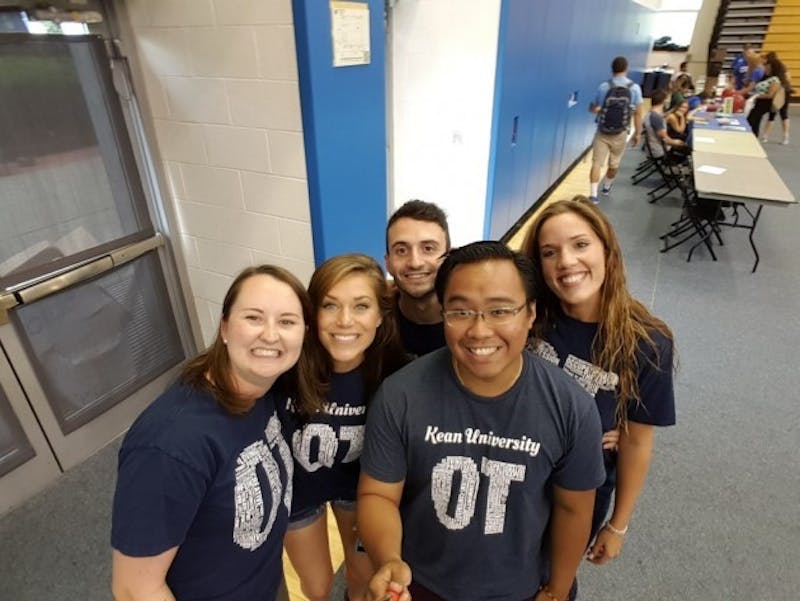On April 21, 2015, from 3:30 p.m. to 6:00 p.m. the student occupational therapy association, affectionately known as SOTA, invited Jack Ballos and Steve Brigham to Kean University. As a part of Occupational Therapy Month, they hosted a screening of Jack Ballos’ award-winning documentary, Destiny’s Bridge.
Occupational therapy helps people to find the tools and strategies they need to overcome barriers such as illness and disability and reach their goals. As a precursor to that, SOTA strives to foster the personal and professional development of occupational therapy students while encouraging educational excellence and promoting community service.
The focal point of the documentary is a community commonly known as Tent City where, in the woods of Lakewood, New Jersey, almost 100 homeless people had settled on public property. Just like any other society, they are characterized by a gamut of personalities, perspectives, and backgrounds. From vegans to alcoholics to minors, they represent a multitude of demographics. As a community they have their own established norms and customs. The only rule in Tent City is that people have to respect their neighbors. Although this rarely happens, when this rule is broken, offenders are asked to leave. Between arrests and police raids, the Tent City residents have faced numerous challenges. The founder of the camp, Steve Brigham, has endured the most persecution. He is the source of the Tent City’s sponsors and donations, and consequently he is regularly targeted.
When the surrounding community became aware of Tent City, the reactions were varying. Most residents of Lakewood were discomforted by the idea of people living in the woods; instead of extending empathy, they made judgments about their lives and character.
As an innovative alternative to their circumstances, Brigham proposed Destiny’s Bridge. In essence, this proposal would include transitional housing. This housing would be provided in the form of tiny homes or small housing that people can afford at a minimum wage job. Through these homes, the homeless can sustain themselves while also experiencing community, ownership, and rehabilitation. These temporary homes would provide the homeless with the means to transition back into mainstream society. When describing the mini homes, Brigham states, ““To somebody living in a tent this is a mansion, this is a castle.” In the West and Midwest, communities like this already exist, such as Dignity Village in Portland.
Unfortunately, the dream of Destiny’s Bridge has yet to be realized because zoning laws will not allow it as it does not meet the qualifications of space. Brigham states, “Our society can afford to produce a system where anybody can have a house. The town has robbed us of that. Towns are creating an atmosphere I calldiscrimination by design. They design it so the poor can't live there. They want the suburban utopian and they do it by structuring the laws and ordinances so the poor can't afford a place in their town.”
Although their alternate ideas went unsupported, the town felt the Tent City residents could not continue to live in their outdoor environment. This spurred tense negotiations between the township, county, and Tent City residents. These negotiations eventually graduated into lawsuits and the legal battle continued for another 18 months. On July 3, 2015, the residents of Tent City were evicted.
One home was preserved as a tribute to the time spent there. Former residents were given a year’s worth of housing but Brigham opted out and he has been homeless since the day the camp closed. As time progresses, he is rejoined by his former Tent City residents who have yet to establish themselves. For many, they simply cannot attain jobs that support basic lifestyles. The cost of living in Ocean County is 22 dollars an hour to afford the amenities of life and most minimum wage jobs pay less than half of that. Moreover, since the disbanding of Tent City, Lakewood created an anti-homeless law and Ocean County has verbally admitted that they do not want a shelter in their county. These new laws combined with the absence of Tent City have left people not only homeless but helpless.
One aspect of Brigham’s campaign for the homeless is remedying the public view of homelessness. Brigham states, “I grew up in a typical middle class home with American ethics and I feel an obligation to try and ease somebody’s burden.” What many people fail to realize is that homelessness is not a one-dimensional problem; it is much more than housing. The homeless are often judged based on their circumstances which are frequently unforeseen and undesirable. As opposed to sympathy or understanding, most people attribute homelessness to drugs, mental illness, or laziness. Society rarely considers extenuating factors.
The residents of Tent City refused to accept homelessness as their destiny. They made homes for themselves when society made it impossible for them to have homes and for over six years, their community thrived. While Tent City has since been demolished and homelessness is still a pervasive issue. Homelessness does not reflect failure; it is not a result of negligence. Many of the homeless community are victims of circumstance. Everyone encounters instances where they need help. In whatever way someone became a part of the homeless population, they should not be written off as undeserving of help or unworthy of saving.





